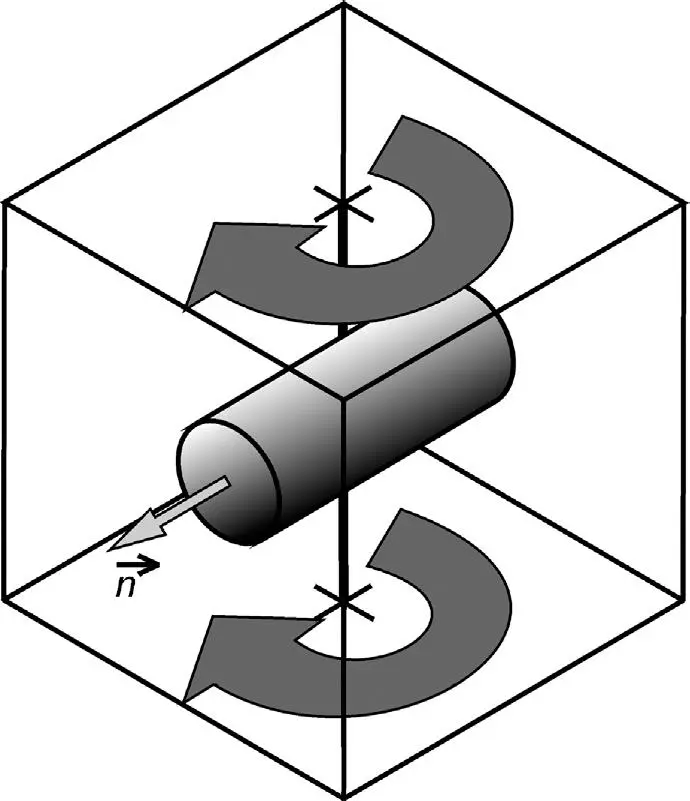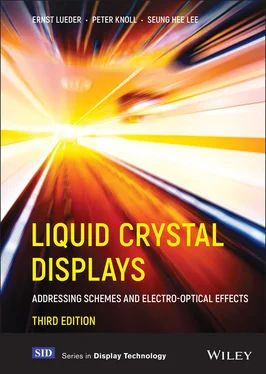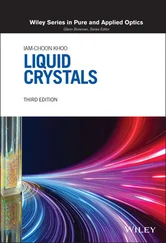
Figure 2.5 Helix of the cholesteric phase
(2.2) 
Materials with Δ ε > 0 are called p -type; their molecules align with the director parallel to the electric field, whereas in n -type materials with Δ ε < 0, they align perpendicular to the field. This holds independent of the direction of the field vector. Values for Δ ε are found in the range from −0.8 to −6 and from 2 to 20. The addition of cyanogroups enlarges Δ ε , whereas fluorine atoms in materials with Δ ε < 0 lower Δ ε even further. Values for four materials are listed in Table 2.1.
The optical anisotropy Δ n concerns the refractive indices n 0for the ordinary beam of light, where the vector of the electrical field oscillates perpendicular to the optical axis that is perpendicular to the director and the refractive index n efor the extraordinary beam of light, where the field vector oscillates in parallel to the director. Hence we obtain
Table 2.1 Properties of liquid crystal materials
|
ZLI-3125 |
14616 |
ZLI-2585 |
14627 |
| TC [°C] |
63 |
54 |
70 |
48 |
| Δ ε (1kHz, 20 °C) |
+ 2.4 |
+ 2.3 |
−4.4 |
−3.5 |
| η [mm 2/s] (20 °C) |
20 |
32 |
45 |
45 |
| n 0= n ┴ |
1.4672 |
1.4554 |
1.469 |
1.4551 |
| ne = n || |
1.5188 |
1.5034 |
1.506 |
1.4893 |
| Δ n (589 nm, 20 °C) |
0.0516 |
0.0480 |
0.037 |
0.0342 |
(2.3) 
and
(2.4) 
and the optical anisotropy
(2.5) 
More explanation about the optic axis and the ordinary beam will be given in Chapter 6. The refractive index n is based on optical frequencies that are very high. Therefore, the equation known from Maxwell’s theory (Born and Wolf, 1980)
(2.6) 
provides for frequencies approaching infinity:
(2.7) 
(2.8) 
and
(2.9) 
The refractive indices depend upon the wavelength λ. Values for Δ n lie in the range Δ n [0.04, 0.45]; some values are listed in Table 2.1. As a rule, materials with a high Δ n are not stable to UV light. Due to the optical anisotropy, the material is birefringent. The speed of light is (Born and Wolf, 1980)
(2.10) 
where c is the speed of light in vacuum. The speeds of light
(2.11) 
and
(2.12) 
where the E -vector oscillates parallel and perpendicular to the director, are different and dependent on the wavelength.
This is the key for the electro-optical effects in liquid crystal cells.
The direction with the larger refraction index n ||exhibits the smaller speed, and hence is called the slow axis, whereas n ┴defines the fast axis.
The dynamic behaviour of LC materials is affected greatly by the viscosity. Too high viscosities at lower temperatures slow down the movement of the molecules and yield the lower temperature limit of LC cells. The proximity to T cprovides the upper temperature limit. The dynamic viscosity η dis defined as
(2.13) 
where F is the force needed to shift a body with the area A with the velocity v over a viscous layer with a thickness d . For displays, the kinematic viscosity
(2.14) 
is used, where d is the density of the viscous material. As for most LC materials, d is around 1 Ns 2/mm 4; the values for η dand η do not differ much. The viscosity depends upon the orientation of the directors. For a random orientation, the bulk or turbid kinematic viscosity is given in Table 2.1. The rotational viscosity is measured according to Figure 2.6, where the vector of the rotation is perpendicular to the director. Values for dynamic rotational viscosities of LCs are 0.02 Pas to about 0.5 Pas. This viscosity is important for the movement of the director in an electric field.
The elastic constants belong to restoring torques if the field of directors is deformed. The three deformations from the equilibrium are splay, twist and bend, with the elastic constants K 11 , K 22and K 33, as shown in Figure 2.7. The dimension is a force. The values are very small in the range of 10 × 10 −2N. These elastic forces determine the equilibrium in the presence of electric and magnetic fields.
A large variety of chemical compounds exhibit the properties of liquid crystals. The basic structure with rings, linking groups and terminal groups is shown in Figure 2.8. Rings can be cyclohexyl, pyridine, dioxane, phenylcyclohexane or phenyldioxane. Fluorinated compounds have a high specific resistance ρ = 5 × 10 15Ω cm. The characteristic temperatures of LC compounds can be shifted by additive ingredients. By this means, Merck’s nematic compounds reached the wide temperature range of operation, from −40 °C to 120 °C, which is very suitable for automotive application. In Table 2.2properties of LC materials with this wide temperature range are listed.

Figure 2.6 The rotational viscosity for rotation of a molecule perpendicular to the director
Читать дальше



























